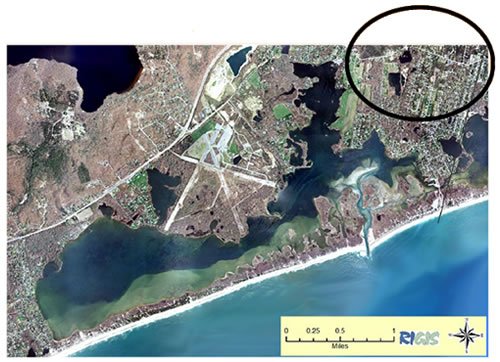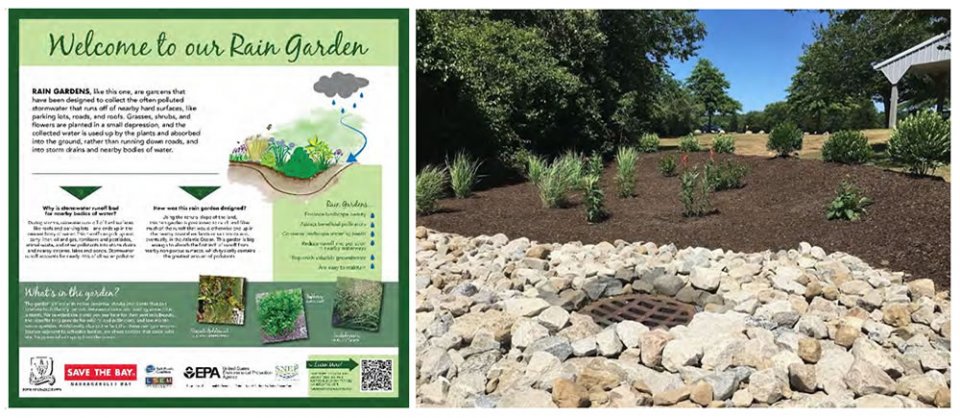From Cesspools to Septic; Lawns to Rain Gardens
 |
| An old cesspool, now illegal |
In the town of Charlestown, RI, nitrogen (N) inputs from these systems are a continuing problem, putting three important coastal salt ponds at risk.
The primary source of nitrogen pollution can be traced to septic systems in seven highly populated zones in town.
Mitigation efforts have been in place since 1994 when a Wastewater Management District was established to properly manage all septic systems.
In 2004, the Town required removal of all cesspools and the upgrade of failing systems to manage bacteria issues, and by 2016 most cesspools had been replaced with septic systems. However, recent sampling by Charlestown showed highly elevated nitrate (NO3) levels in the groundwater in its more populated coastal areas.
This nitrogen- rich ground water eventually flows into the three salt ponds causing eutrophication and impairing water quality. Nitrogen pollution coming from ground water and stormwater lead to hypoxic conditions, cyanobacteria blooms, and reduced water clarity in the ponds, which all impact the local economy through mandated closure of ponds to shellfishing and swimming due to high bacteria levels.
While strategies on how to best manage this issue have been tested and implemented for the past 30 years, recent funding from EPA's Southeast New England Program enabled the Town to create a unique and effective blueprint for significantly reducing nitrogen-loading into the watershed.
Collaborating with the University of Rhode Island's (URI) Laboratory of Soil and Ecology, the New England Wastewater Training Program, Save the Bay, and the Salt Ponds Coalition, Charlestown developed and completed a Coastal Watershed Protection and Restoration Program this year.
Elements of the program included testing and
monitoring 50 existing nitrogen-reducing innovative and alternative (I/A)
septic systems (also known as Alternative and Experimental (A/E) technologies)
to establish baseline system performance; upgrading systems in the most densely
populated areas to nitrogen reducing septic system technology; and implementing
additional stormwater and fertilizers controls.
Charlestown demonstrated that regular monitoring of N-reducing I/A septic systems is key to effectively improving their performance. Based on that information, the Town established a program to upgrade 15 of the substandard or older unpermitted systems in two of the densely populated areas, which resulted in a total net nitrogen reduction of 357 pounds per year and 4.7% of the total nitrogen loading from those areas.
Fertilizer inputs in areas with high maintenance lawns were found to account for up to 20% of nitrogen-loading into the groundwater (URI NEMO, 2014). To address this, a program was created to promote best management practices in lawn care.
Under this program, professionals who agree to follow established best management practices (BMPs) for lawn care and eliminate or reduce application of nitrogen fertilizer are certified as Charlestown Recommended Landscapers.
To aid homeowners and landscapers, a Fertilizer Calculator (xlsx) was also developed to assist in the management of fertilizer application.
To demonstrate the use of stormwater BMPs, six demonstration rain gardens were installed, in partnership with Save the Bay, to mitigate the impacts of stormwater in densely populated areas. These rain gardens are an excellent educational resource for residents and visitors as they demonstrate stormwater infiltration, groundwater recharge, the role of native plants, and localized flood reduction.
With the combination of monitoring and implementation, the SNEP-funded Charlestown Coastal Watershed Protection and Restoration Program was a success! Within four years, the program demonstrated the need to upgrade old septic systems to nitrogen-reducing I/A systems and built continued interest from residents to do so.
To
learn more about this project, please visit the project web page, or email us at SECoastalNE@epa.gov.

